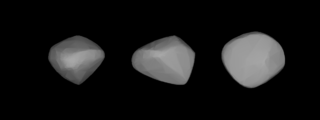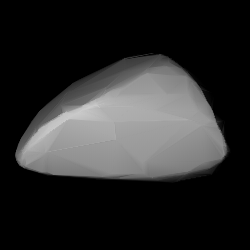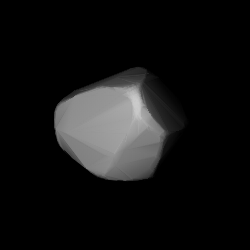
25 Phocaea is a stony asteroid from the inner regions of the asteroid belt, approximately 75 kilometers in diameter. It is the parent body of the Phocaea family. Discovered by Jean Chacornac in 1853, it was named after the ancient Greek city of Phocaea.

391 Ingeborg is an asteroid and second-largest Mars-crosser on an eccentric orbit from the asteroid belt. It was discovered by German astronomer Max Wolf on 1 November 1894, at the Heidelberg Observatory in southwest Germany. When discovered, it was observed for a couple of weeks, and follow-up observations were made in 1901 and 1904. The stony S-type asteroid has a rotation period of 26.4 hours and measures approximately 17 kilometers in diameter. Any reference of the asteroid's name to a person is unknown.
587 Hypsipyle, provisional designation 1906 TF, is a stony Phocaea asteroid from the inner regions of the asteroid belt, approximately 12 kilometers in diameter. It was discovered on 22 February 1906, by Germany astronomer Max Wolf at Heidelberg Observatory in southwest Germany.
797 Montana, provisional designation 1914 VR, is a stony asteroid from the middle region of the asteroid belt, approximately 22 kilometers in diameter. It was discovered on 17 November 1914, by Danish astronomer Holger Thiele at Bergedorf Observatory in Hamburg, Germany. It was later named for the discovering observatory.
925 Alphonsina, provisional designation 1920 GM, is a stony Hansian asteroid from the central region of the asteroid belt, approximately 58 kilometers in diameter. It was discovered on 13 January 1920, by Catalan astronomer Josep Comas i Solà at the Fabra Observatory in Barcelona, Spain. The S-type asteroid has a rotation period of 7.88 hours. It was named for the Spanish Kings Alfonso X and Alfonso XIII.

1103 Sequoia is a bright Hungaria asteroid from the innermost region of the asteroid belt, approximately 7 kilometers in diameter. It was discovered on 9 November 1928, by German astronomer Walter Baade at the Bergedorf Observatory in Hamburg, Germany, who named it after the Sequoia National Park located in California.

1150 Achaia ; prov. designation: 1929 RB) is a stony background asteroid from the inner regions of the asteroid belt. It was discovered by Karl Reinmuth at Heidelberg Observatory on 2 September 1929. The S-type asteroid has a notably long rotation period of hours 61 hours and measures approximately 7.8 kilometers in diameter. It is named for the Greek region of Achaia.

1568 Aisleen, provisional designation 1946 QB, is a stony Phocaea asteroid from the inner regions of the asteroid belt, approximately 12.5 kilometers in diameter. It was discovered on 21 August 1946, by South African astronomer Ernest Johnson at Johannesburg Observatory in South Africa. It is named for the discoverer's wife, Aisleen Johnson.

1672 Gezelle, provisional designation 1935 BD, is a carbonaceous asteroid from the outer region of the asteroid belt, approximately 27 kilometers in diameter. It was discovered on 29 January 1935, by Belgian astronomer Eugène Delporte at Royal Observatory of Belgium in Uccle, Belgium. It was later named after Flemish poet and Roman Catholic priest Guido Gezelle.

1987 Kaplan, provisional designation 1952 RH, is a stony Phocaea asteroid from the inner regions of the asteroid belt, approximately 14 kilometers in diameter. It was discovered on 11 September 1952, by Soviet astronomer Pelageya Shajn at the Simeiz Observatory on the Crimean peninsula. The asteroid was named after Soviet astrophysicist Samuil Kaplan.
5430 Luu, provisional designation 1988 JA1, is a stony Phocaea asteroid from the inner regions of the asteroid belt, approximately 7 kilometers in diameter. It was discovered on 12 May 1988, by American astronomer couple Carolyn and Eugene Shoemaker at Palomar Observatory, California, and later named after astronomer Jane Luu.

1353 Maartje, provisional designation 1935 CU, is an Eoan asteroid from the outer regions of the asteroid belt, approximately 37 kilometers in diameter. It was discovered on 13 February 1935, by Dutch astronomer Hendrik van Gent at the Union Observatory in Johannesburg, South Africa. The asteroid was named after Maartje Mekking, daughter of a staff member at the Dutch Leiden Observatory.
2696 Magion, provisional designation 1980 HB, is a dark background asteroid and a slow rotator from the inner regions of the asteroid belt, approximately 21 kilometers in diameter. It was discovered on 16 April 1980, by Slovak astronomer Ladislav Brožek at the Kleť Observatory in former Czechoslovakia. The X-type asteroid has an ambiguous rotation period of 480 hours and is possibly a tumbler. It was named for the first Czechoslovak satellite, Magion 1, launched in 1978.

1841 Masaryk (prov. designation: 1971 UO1) is a carbonaceous background asteroid from the outer region of the asteroid belt, approximately 46 kilometers in diameter. It was discovered on 26 October 1971, by Czech astronomer Luboš Kohoutek at Bergedorf Observatory in Hamburg, Germany. The asteroid was named after the first President of Czechoslovakia, Tomáš Garrigue Masaryk.

1512 Oulu, provisional designation 1939 FE, is a dark Hildian asteroid, slow rotator and possibly the largest known tumbler orbiting in the outermost region of the asteroid belt. With a diameter of approximately 80 kilometers, it belongs to the fifty largest asteroids in the outer main-belt. The body was discovered on 18 March 1939, by Finnish astronomer Heikki Alikoski at Turku Observatory in Southwest Finland and named for the Finnish town Oulu.
1644 Rafita, provisional designation 1935 YA, is a stony asteroid from the middle region of the asteroid belt, approximately 15 kilometers in diameter. It is the namesake of the Rafita family, a family of stony asteroids in the intermediate main-belt. However, Rafita is a suspected interloper in its own family. It was discovered on 16 December 1935, by Spanish astronomer Rafael Carrasco Garrorena at the Royal Observatorio Astronómico de Madrid in Spain, and named in memory of the discoverer's son.

1350 Rosselia, provisional designation 1934 TA, is a stony Koronian asteroid from the outer regions of the asteroid belt, approximately 22 kilometers in diameter. Discovered by astronomer Eugène Delporte at the Royal Observatory of Belgium in 1934, the asteroid was later named after Marie-Thérèse Rossel, editor of the Belgian newspaper Le Soir.

1364 Safara, incorrectly designated 1935 VB, is an Eoan asteroid from the outer regions of the asteroid belt, approximately 25 kilometers in diameter. It was discovered on 18 November 1935, by French astronomer Louis Boyer at the Algiers Observatory in Algeria, North Africa. The asteroid should have been designated 1935 WB, as the letter "V" only covers discoveries made during 1–15 November. It was named after André Safar, presumably an acquaintance of the discoverer from Algiers.

1623 Vivian is a carbonaceous Themis asteroid from the outer region of the asteroid belt, approximately 25 kilometers in diameter. It was discovered on 9 August 1948, by South African astronomer Ernest Johnson at Johannesburg Observatory in South Africa. It was named after Vivian Hirst, daughter of British astronomer William P. Hirst.
24827 Maryphil is a stony Phocaea asteroid from the inner regions of the asteroid belt, approximately 6 kilometers in diameter. It was discovered on 2 September 1995, by American astronomer Timothy Spahr at the Catalina Station near Tucson, Arizona, who named it for his parents, Mary & Phil Spahr.













